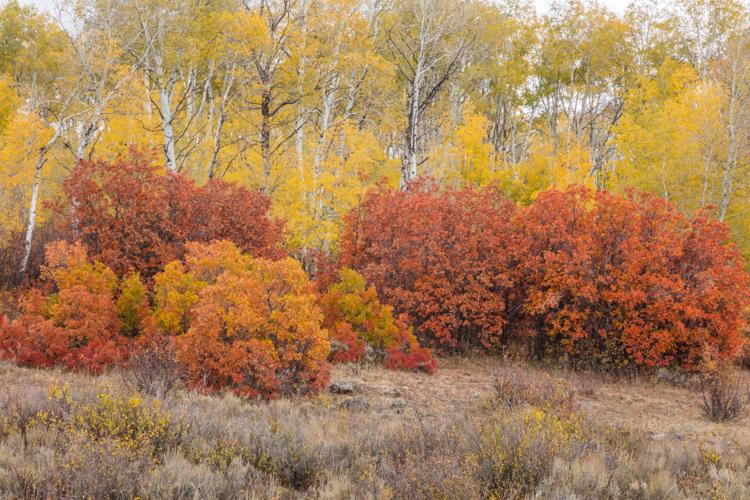While aspens steal the show in Colorado, this native tree also delivers fall colors
Come fall in Colorado, aspen gets all the love. But yellow isn’t the only color in the hilly palette.
However short lived and uncertain the display, it’s all the more reason to appreciate the underappreciated native that is Gambel oak.
For fall colors, Pikes Peak region destination suggests ‘calling Mother Nature’
Says Andy Schlosberg of the Colorado State Forest Service’s Woodland Park office: “Anywhere along the Front Range where you’re looking up and see those pretty oranges and reds, that’s almost always that oak.”
Quercus gambelii is the scientific name, after an adventurous naturalist whose life was cut all too short, like those lobed leaves against the wind and nighttime chill. William Gambel died of typhoid fever in 1849 at the age of 26.
Scrub oak is the common name, unflattering.
“It’s been treated almost like a pest or a weed because of its root-sprouting capability and its shrubby nature kind of gets in the way,” says Stan Kitchen, who previously studied the species with the Rocky Mountain Research Station.
For Colorado’s most famous photographer, it’s more than welcome. “Otherworldly,” John Fielder calls it.

A swath of Gambel oak across Daniels Park near Sedalia, as captured by John Fielder. The photographer’s 2023 scenic calendar is available at Amazon and Barnes and Noble. Photo by John Fielder
“When Gambel oak turns its maximum red, that crimson-blood red, and it backlights, it’s just outrageous,” he says.
Even more so, he says, in those rare frames that blend it with shiny aspen in the higher elevations.
The trees are different, of course. One is defined by a thin, white trunk, the other dark and rough. One might be called regal, the other gnarly with its nonconforming branches and twigs. One’s leaf is smooth and petite, the other a bit hairy on the backside.
But they are more similar than meets the eyes.
The chemical makeup is different, explaining the different colors, but the process by which the leaves turn on the way to shedding is the same.
Royal Gorge Railroad offers a special way to enjoy Oktoberfest
The nutrient-giving days become shorter, the nights cooler. “The chlorophyll drains, and the leaves change color,” Schlosberg says.
And their process of cloning is similar. Gambel oak is prolific thanks to a deep root system that sends shoots up fast after fire, like aspen. Thanks to those deep, water-absorbing roots and xeromorphic, water-storing leaves, oak is strong, too, against drought. It lives just fine on the West’s dry, hardscrabble ground where the sun shines.
It is “an important contributor to our state’s biodiversity,” reports Colorado Native Plant Society.
The thick groves provide shelter and habitat for birds and mammals big and small, especially in winter. Bears fatten up on the acorns before hibernation, sharing with deer, elk and turkey. Oak serves as the lifelong home of the Colorado hairstreak, the state butterfly.
And it serves as watershed protection in many places, such as where Kitchen lives near Utah’s Wasatch range.
“Pretty steep slopes,” he says. “And so one of the things that helps hold that slope in place are those oak clones that hold the soil and intercept both snow and rain.”
Kitchen co-authored a 2016 report on Gambel oak with scientists around the southern Rockies.
“Although it is ubiquitous in Colorado and Utah,” they wrote, “surprisingly little research has been devoted to understanding Gambel oak or mixed mountain shrub stands.”
Colorado fall colors: 5 best places to see the gold rush
That could be detrimental, they found, considering “changes in climate, increase in drought, changing forest conditions and health, and the dramatic spread of homes and structures in the wildland-urban interface in Gambel oak habitat.” The report cited devastating, oak-fueled fires like the Waldo Canyon fire in Colorado Springs.
From his station in Woodland Park, Schlosberg says mitigation has been a priority.
“You don’t want that carpet of oak that we tend to see right up against a house,” he says, while in the forest “we try to get rid of those ladder fuels that can carry flames up into the canopy.”
It’s a “tricky balance” between protecting infrastructure and conserving ecosystems, Kitchen says. “How to properly manage oak as part of a conifer forest, it needs work,” he says.
In the meantime, it’s nice to look at. Don’t tell Fielder otherwise.
And don’t tell him bluebird days go best with fall colors. Not necessarily, the photographer says. Just as he values oak, he values gray skies as well.
“Even in cloudy light, it becomes an extraordinary subject,” he says.




















